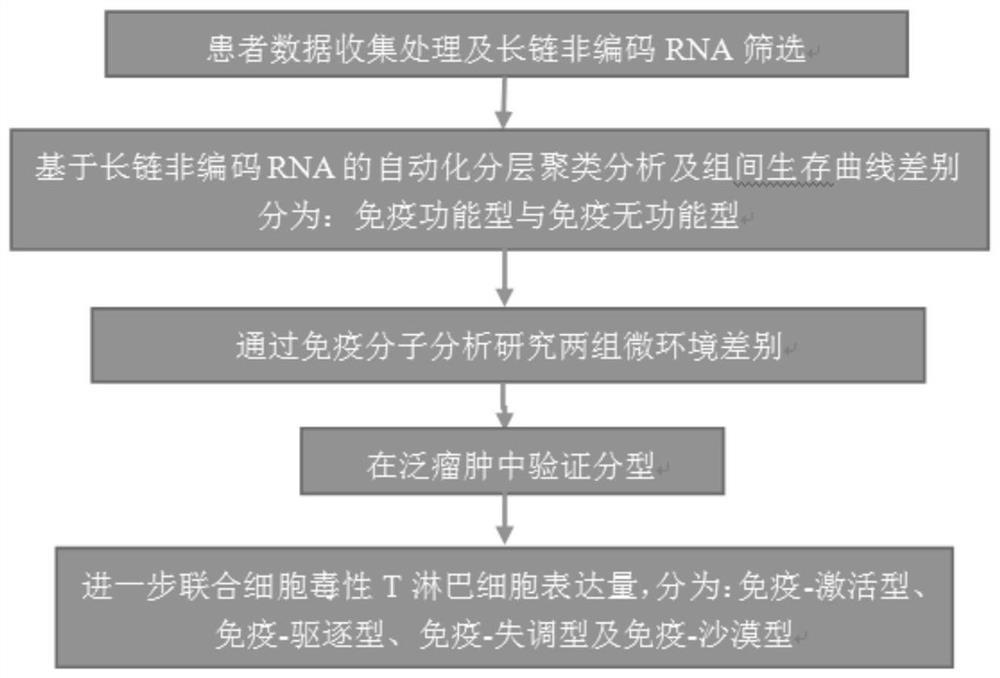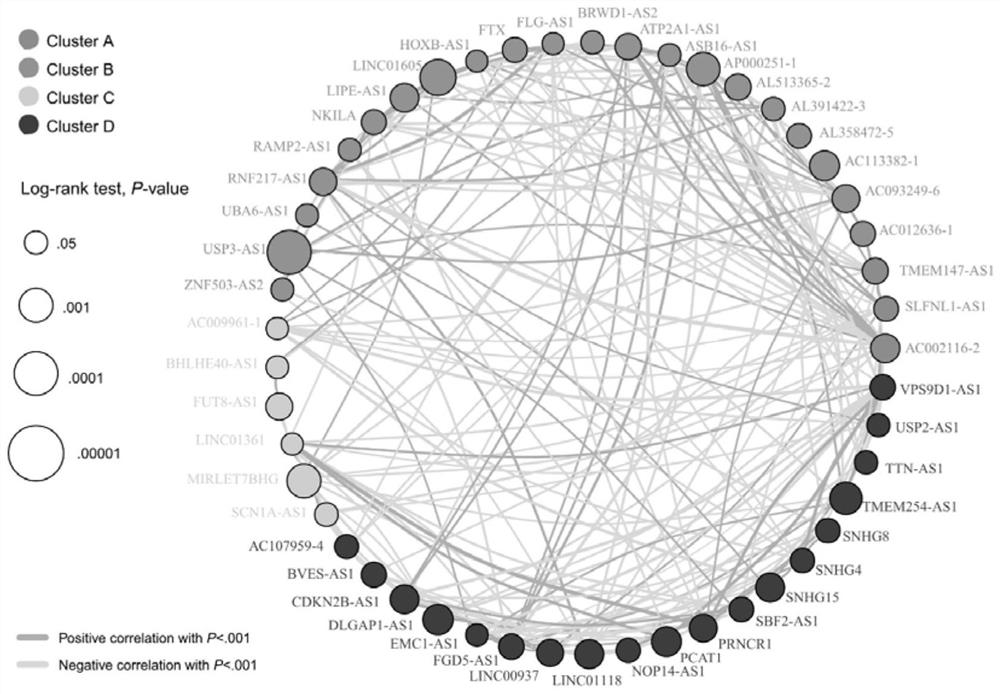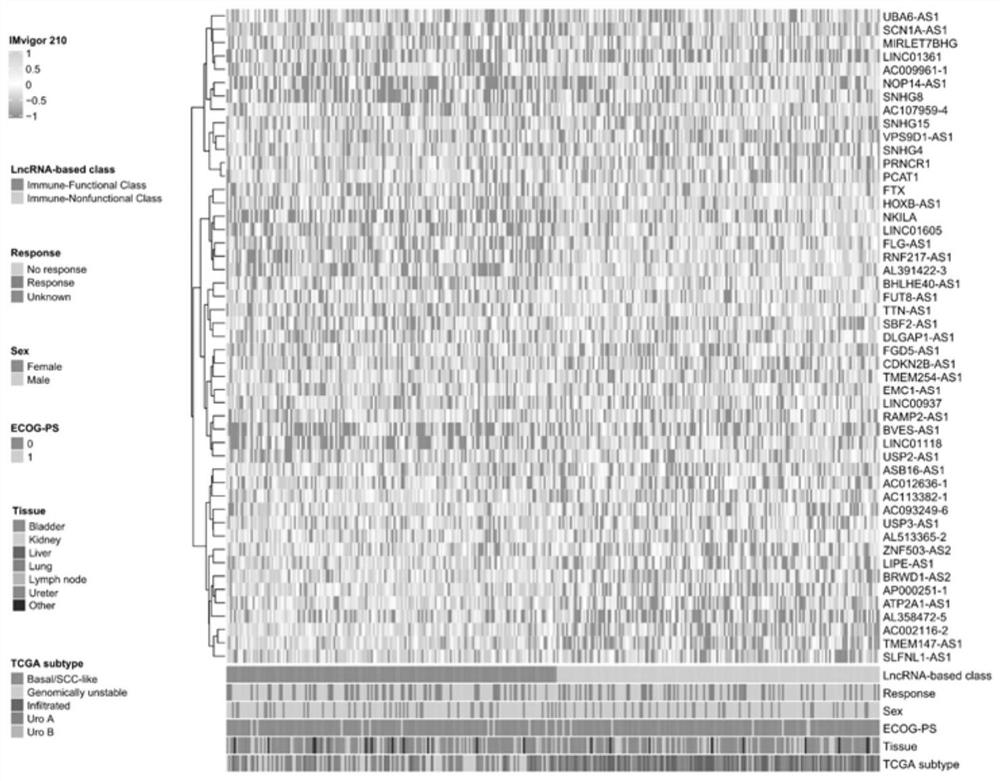Tumor immune typing method based on lncRNA markers
An immunophenotyping and marker technology, applied in the field of biomedicine, can solve problems such as the inability to meet individualized immunotherapy
- Summary
- Abstract
- Description
- Claims
- Application Information
AI Technical Summary
Problems solved by technology
Method used
Image
Examples
Embodiment 1
[0036] Example 1 Screening lncRNA
[0037] 1. Data source
[0038] 348 patients with bladder cancer treated with the PD-L1 inhibitor atotuzumab from the IMvigor 210 trial (NCT02951767 / NCT02108652, http: / / research-pub.gene.com / IMvigor210CoreBiologies) and 70 patients with melanoma from the TCGA immunologic Treatment cohort (https: / / xenabrowser.net / datapages / ?cohort=GDC%20TCGA%20Melanoma%20(SKCM)&removeHub=https%3A%2F%2Fxena.treehouse.gi.ucsc.edu%3A443). In addition, we included 513 patients with lung adenocarcinoma (LUAD), 493 patients with lung squamous cell carcinoma (LUSC), 1082 patients with breast cancer, 406 patients with bladder cancer and 457 patients with melanoma from multi-cohort studies in TCGA. tumor patients. The data of each research patient includes all of its LncRNA gene expression, CTL expression, tumor microenvironment immune molecule expression and gene expression, and patient survival and prognosis information data.
[0039] 2. lncRNA screening
[0040]...
Embodiment 2
[0047] Verification analysis of embodiment 2 lncRNA in pan-tumor
[0048] For the data of other tumor patients we obtained above, including two groups of melanoma patients (70 cases and 457 cases), 513 cases of lung adenocarcinoma patients, 493 cases of lung squamous cell carcinoma patients, 1082 cases of breast cancer patients and 406 cases For patients with bladder cancer, the process of Example 1 was repeated for validation analysis. The results showed that it had prognostic significance in lung adenocarcinoma, bladder cancer and melanoma (lung adenocarcinoma: HR=0.75, 95% CI (0.57-0.99), P=0.038; bladder cancer: HR=0.68, 95% CI ( 0.51-0.92), P=0.011; melanoma: HR=0.62, 95% CI (0.47-0.81), P Figure 7 ). Therefore, the lncRNA and typing method have significance for anti-tumor immunotherapy efficacy and prognosis prediction of pan-tumor patients.
Embodiment 3
[0049] Example 3 Combined CTL (cytotoxic T lymphocyte) expression type
[0050] According to the current research, it is found that the expression of CTL is closely related to a variety of immune molecules, including a variety of immune cells, immune checkpoints and human leukocyte antigen (see Figure 8 ). Therefore, we tried to analyze the survival prognosis of multiple tumors including bladder cancer, lung adenocarcinoma, breast cancer, Her-2 positive breast cancer, and melanoma, and draw survival curves (such as Figure 9 ). The results showed that the expression of CTL was significantly correlated with the prognosis of patients, and compared with low expression of CTL, patients with high expression of CTL had a significant survival advantage.
[0051] Based on the above, we tried to combine lncRNA grouping and CTL expression to further stratify the bladder cancer patients in the TCGA cohort into four groups, including lncRNA functional type-high expression of CTL, lncRN...
PUM
 Login to View More
Login to View More Abstract
Description
Claims
Application Information
 Login to View More
Login to View More - R&D
- Intellectual Property
- Life Sciences
- Materials
- Tech Scout
- Unparalleled Data Quality
- Higher Quality Content
- 60% Fewer Hallucinations
Browse by: Latest US Patents, China's latest patents, Technical Efficacy Thesaurus, Application Domain, Technology Topic, Popular Technical Reports.
© 2025 PatSnap. All rights reserved.Legal|Privacy policy|Modern Slavery Act Transparency Statement|Sitemap|About US| Contact US: help@patsnap.com



